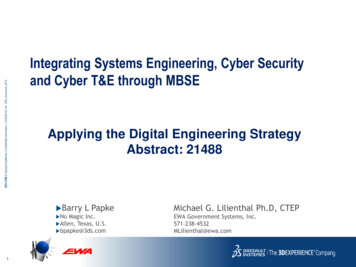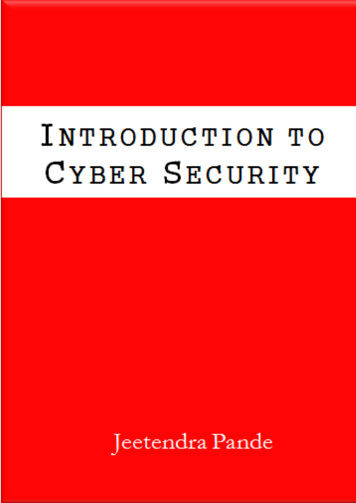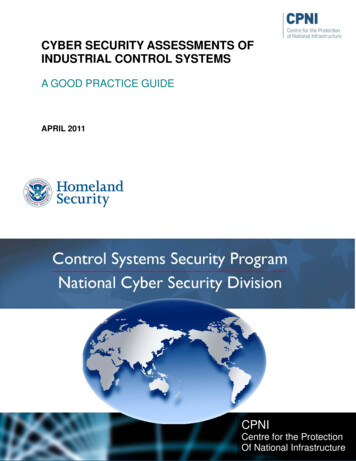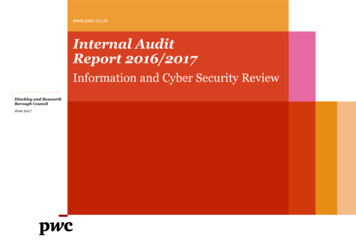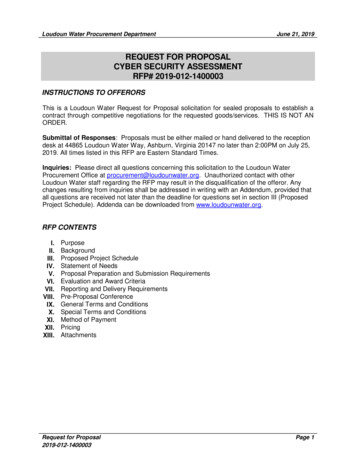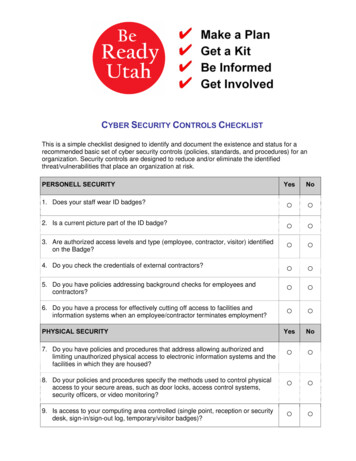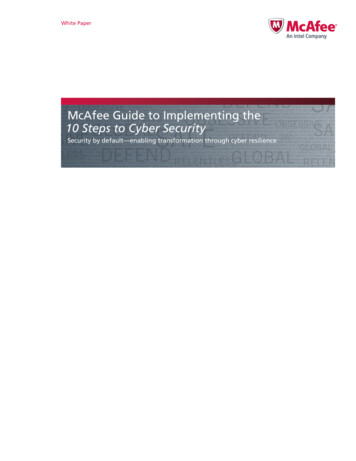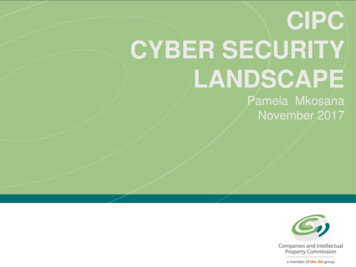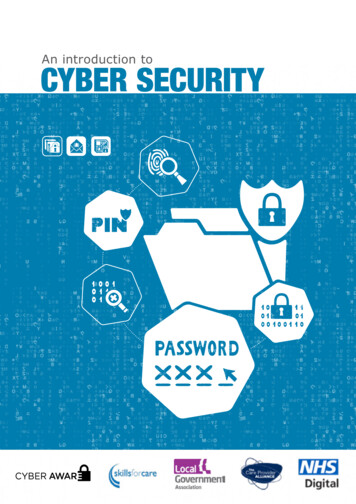
Transcription
An introduction toCYBER SECURITY
An Introduction to Cyber SecurityDecember 20171. FOREWORDThank you for taking the time to read this guidance, which has beenproduced for Care Providers and for anyone else who would find it ofassistance.It was written by the Care Provider Alliance in collaboration with theSocial Care Programme at NHS Digital, with significant contributions frommany other agencies including the Home Office (Cyber Aware Team) andthe National Cyber Security Centre. The guidance can be found on theCare Provider Alliance website.For extra information about cyber security, the guidance includes links toweb pages from Government approved organisations. They also containimportant information about other areas such as: The Data Security andProtection Toolkit (replacing the existing Information Governance ToolkitApril 2018) and GDPR (applies from 25th May 2018). Please see‘5. Resource Library’ for more details.If you have feedback about the websites used in this guidance, pleasecontact the organisation concerned.2. TECHNOLOGY AND BENEFITSThere are fantastic benefits to embracing technology and workingsecurely online in health and social care. Technology allows greater andfaster information sharing, so we can improve the quality of care andsupport which we provide e.g. personalised care planning, transfers ofcare, viewing medications, etc. Individuals can fully participate and havebetter access to, and input into, their records.However, as we use technology more, we must continue to do all wecan to keep data safe and secure, ensuring that disruption to care andsupport at best is avoided or that any disruption is minimised.The global ransomware attack in May 2017, which in the UK particularlyaffected the NHS, is a reminder to us all why it is worth taking thenecessary precautions.2
An Introduction to Cyber SecurityDecember 20173. WHAT IS CYBER SECURITY?Cyber security is the name for the safeguards taken to avoid or reduceany disruption from an attack on data, computers or mobile devices.Cyber security covers not only safeguarding confidentiality and privacy,but also the availability and integrity of data, both of which are vital forthe quality and safety of care.Security breaches can occur when we use paper records, sendinformation using fax machines and even verbally. However, theconsequences of security breaches with digital information are potentiallyfar more severe, as information can be distributed more easily and to afar wider audience.Cyber-breaches are costly – in terms of expense, recovery time andthrough damage to reputation. In a Government Cyber Breaches Surveyin 2017, 46% of businesses reported a cyber-breach or attack.That is why cyber security is a high priority for business and why all staffmust be aware of how to implement protective measures.Individuals should also be aware of basic cyber security safeguards forpersonal use and when participating in the management and coordinationof their care and support.4. IMPROVING CYBER SECURITYCyber security is a constantly changing area and sometimes can seemquite confusing.However, there are many effective and relatively simple steps that can betaken to protect information and protect you and your organisation.Taking some simple actions and practising safe behaviours will reduceonline threats.3
An Introduction to Cyber SecurityDecember 2017The most important steps to improve online security are ensuring you:a. MOVE AWAY FROM USING UNSUPPORTED SOFTWAREThis is when software e.g. operating systems such as Windows, apps,web browsers, etc. are no longer updated by the supplier. Althoughthe software will continue to operate, it will no longer protect againstonline threats through updates or patching (a software update, oftenrelates to improving security).If a security weakness is discovered, software can be compromisedand become vulnerable to a cyber-attack.For benefits to be gained from up-to-date security measures, such asimproved speed and efficiency, only use supported software on yoursystems and devices (see b.). If you must use unsupported software,ensure that you properly manage the risk by having a strong firewalland up-to-date anti-virus and/or anti-malware software (see c.).For more information, please click here.b. A LWAYS DOWNLOAD AND INSTALL THE LATESTSOFTWARE AND APP UPDATESSoftware updates are designed to fix weaknesses in software andapps which could be used by hackers to attack your device. Installingthem as soon as possible helps to keep your device secure.You can set desktops, laptops, smartphones and tablets toautomatically install software updates when an update is available.You can choose to install updates overnight whilst your device isplugged in, or you can set your device to automatically update whenyou are connected to Wi-Fi.For more information, please click here.4
An Introduction to Cyber SecurityDecember 2017c. RUN UP-TO-DATE ANTI-VIRUS SOFTWAREYour computers, tablets and smartphones can easily become infectedby small pieces of software known as malware. Common typesinclude viruses or spyware and ransomware. To help prevent infection,install internet security software, like anti-virus and/or anti-malwareon your devices and keep it up to date.For more information, please click here.d. USE STRONG PASSWORDSPasswords should be easy to remember and difficult to guess. It’sbest not to use words such as your child’s name, pet’s name or yourfavourite sports team as this type of information might be easilyviewed on your social media page e.g. Facebook.Use 3 random words to create a strong passwordNumbers and symbols can still be used but using three random wordsis the key to creating a strong password.Use a strong, separate password for your email and otherimportant accountsThis means if hackers steal your password for one of your lessimportant accounts they cannot use it to access your most importantones such as your main email account. Hackers could potentially useyour email to access many of your personal accounts and find outpersonal information, such as your bank details, address or date ofbirth, leaving you vulnerable to identity theft or fraud.For your most important accounts, if it’s available, you should useTwo-Factor Authentication. This means involving a second step afterentering your password e.g. providing a fingerprint, answering asecurity question, or entering a unique code sent to your device.For more information, please click here.Remember – always keep your passwords secret5
An Introduction to Cyber SecurityDecember 2017e. DELETE SUSPICIOUS EMAILS AND AVOID CLICKINGON UNKNOWN ATTACHMENTS OR LINKSEmail is an excellent communication tool but is frequently usedto deliver unwanted or unwelcome material, often referred to as‘spam’ or ‘junk’ email. At best this is annoying and at worst it canbe malicious, causing considerable harm to your computer andorganisation.Delete suspicious emails and do not click on links or openattachments in these emails before you delete them as they maycontain fraudulent requests for information or contain links to viruses.Do not respond to such ‘phishing’ emails (a scam where criminalstypically send emails to thousands of people) even if they seem tocome from a company or person you may know, because doing socan confirm the address is legitimate to the sender.For more information, please click here.f. BACK UP YOUR DATAIf your device is infected by a virus or accessed by a hacker, yourdata may be damaged, deleted, stolen or even held to ransom, whichmeans you won’t be able to access it.You should therefore safeguard your most important data bybacking up to a secure external hard drive or storage system basedin the Cloud.You should also ensure you regularly test your back-ups and, ifyou are saving confidential data off-site e.g. the Cloud, follow allappropriate data protection measures and government standards andguidance that relate to health and social care organisations.For more information, please click here.6
An Introduction to Cyber SecurityDecember 2017g. TRAIN YOUR STAFF TO BE CYBER AWAREMake sure staff are trained to know the benefits of operating digitally,but are also aware of cyber security threats and how to deal withthem. Due to the rapid development and changes in digital technologyit is a good idea to add cyber security to your annual training plans/matrix.NHS Digital’s Data Security Awareness Programme, in conjunctionwith Health Education England, includes Data Security AwarenessTraining which is for everyone working in health and care. It has beendesigned to inform, educate and upskill different groups of staff indata security and information sharing.The Open University has developed a generic Introduction to CyberSecurity course supported by the National Cyber Security Programme.For more information, please click here.h. MANAGE SECURITY RELATIONSHIPS WITHSUPPLIERS AND PARTNERSAs your organisation grows and works with more suppliers andpartners, you become a link in one or more complex supply chains.It is important to observe good practice (and in many cases,compliance) because vulnerabilities will place not only your ownorganisation at risk, but also others within the supply chain.If you use third-party managed IT services, check your contractsand service level agreements, and ensure that whoever handles yoursystems and data has security controls in place.One way to demonstrate that you have the security controls in placeis to undertake a basic assessment and achieve your Cyber Essentialscertificate. You can ask your suppliers to do the same.For more information, please click here.7
An Introduction to Cyber SecurityDecember 20175. RESOURCE LIBRARYThe information below lists some of the organisations who offer advice tothe public and businesses, including those in health and social care, aboutthe best ways to protect devices and data.Taking these actions will also be valuable with regards to the Departmentof Health guidance, Data Security and Protection for Health and CareOrganisations, which outlines the steps expected from health and careorganisations up to and beyond April 2018.NHS DigitalNHS Digital is where you will find information about The Data Securityand Protection Toolkit which will be replacing the existing InformationGovernance Toolkit in April 2018.Good Practice Guides are also available as well as information aboutnational systems for health and care, such as NHSmail.NHS Digital also has a Data Security Centre which has live reportingon cyber security threats in health and care. By going to the website,anyone can sign up to receive updates on the latest threats. The aim is tohelp health and care organisations respond to cyber-attacks quickly andeffectively to minimise impact.The Information Governance Alliance can also be found on the NHSDigital website.The Information Commissioner’s Office (ICO)The ICO is a UK independent body set up to uphold information rights,organisations’ obligations and how to comply, including protectingpersonal information and providing access to official information.This includes guidance for organisations about GDPR which will apply inthe UK from the 25th May 2018.8
An Introduction to Cyber SecurityDecember 2017Cyber AwareThe Cyber Aware website aims to influence businesses and individuals toadopt simple secure online behaviours to help protect themselves fromcyber criminals. It is delivered by the Home Office alongside the NationalCyber Security Centre, and funded by the National Cyber SecurityProgramme in the Cabinet Office.For further information about the Cyber Aware campaign or to find printready and digital communications materials visit the Cyber Aware toolkitor email cyberaware@homeoffice.x.gsi.gov.ukGet Safe OnlineThe Get Safe Online website aims to provides comprehensive practicaladvice and resources on how to protect yourself and your business.The site also provides advice on a wide range of topics including; MobileDevices, Fraud, Identity Theft, Network and Computer Security, UserAccounts, Business Security Plan’s, Business Continuity & DisasterRecovery, etc.There is also a Jargon Buster.The National Cyber Security Centre (NCSC)The NCSC site is the authority on cyber security and has some usefulguidance and resources. The NCSC’s main purpose is working togetherwith organisations and businesses and individuals to reduce the cyber riskby improving cyber security and cyber resilience to ensure the UK is thesafest place to live and do business online.There is also a Glossary.Action FraudAction Fraud is the UK’s national reporting centre for fraud andcybercrime where fraud can be reported if you have been scammed,defrauded or experienced cybercrime.Report Fraud Online: www.actionfraud.police.uk/report fraudTelephone: 0300 123 2049
3 A ntroductio ybe ecurity December 2017 3. WHAT IS CYBER SECURITY? Cyber security is the name for the safeguards taken to avoid or reduce any disruption from

